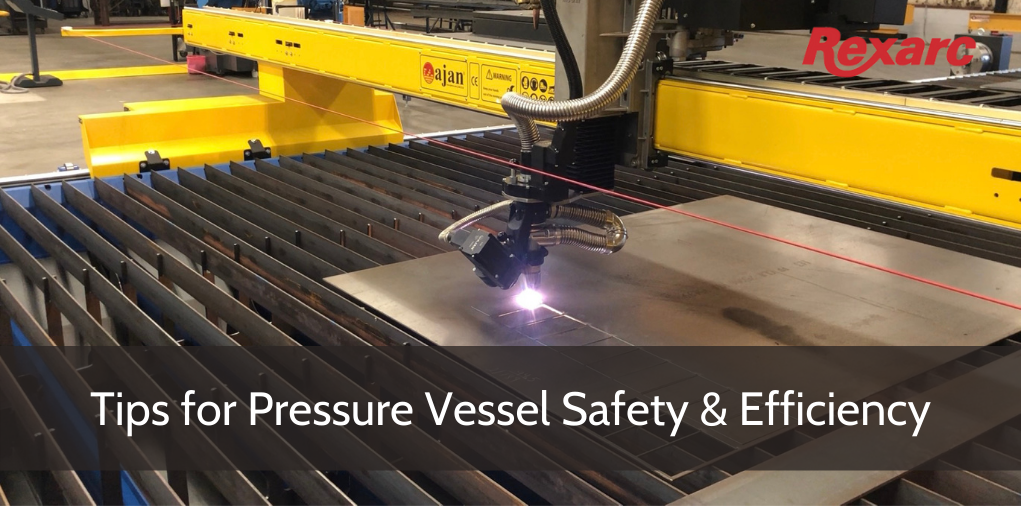Safe and efficient operation of your pressure vessel can be interrupted by poor materials and weld choices. Making good decisions from the earliest stages of specification and design will ensure the efficient performance expected.
In the engineering phase, be sure to consider or share all factors that could affect the operation of your vessel. There are obvious factors that can impact pressure vessel performance. For example, the chemicals in the tank can be corrosive, damaging the tank materials. Other factors, such as operating temperatures and physical environment, can also be at play in tank deterioration.
Your fabrication partner can help you determine the best construction materials and welds. Also, it is helpful to have a basic knowledge of materials, especially stainless steel, one of the most popular tank materials.
Stainless Steel Options
Many different materials are available for pressure vessels such as plastic, and various grades of steel. Stainless or coated stainless steels are frequently chosen for durability and value. Stainless steel is readily available, easy to use in fabrication, and stands up to temperature and environmental pressures well. However, making the proper choice requires some knowledge of each alloy’s properties.
We will work with you to understand how and where you’ll use your pressure vessel for the best possible results. Stainless steel alloys include:
- 304: This is 18/8 steel and the most common stainless-steel grade used in food industry applications. Grade 304 resists corrosion and endures a wide range of working environments, making it extremely popular.
- 304L: The low-carbon grade of 304, this option helps minimize chromium carbide precipitation during welding. It is less susceptible to intergranular corrosion and is suited for severe corrosive conditions.
- 316: Grade 316 can resist crevice corrosion, pitting in chloride environments, and can withstand high temperatures. It is a molybdenum-bearing grade that exhibits better corrosion-resistant properties than 304.
- 316L: This grade is used for fabricating pressure vessels operating in high-temperature environments, such as heat exchanger tubes and scrubbers. This is a low-carbon grade comprising molybdenum, resistant to pitting and corrosion. Grade 316L offers high formability and high deformation resistance. The grade exhibits excellent tensile and rupture strength at high temperatures. It withstands high pressures and offers exceptional resistance in acidic and hard-water environments.
- 317: This is a non-magnetic stainless-steel grade, with a high concentration of nickel, molybdenum, and chromium. The high molybdenum concentration improves its resistance to pitting from chlorides, making it an excellent choice for applications in the chemical and marine industries.
- 317L: It is a low-carbon grade of 317, which offers excellent corrosion resistance over other grades we offer. This 317 variety does not produce precipitate during welding and exhibits improved corrosion resistance in environments containing halides, sulfurous media, and chlorides.
There are many factors to consider when choosing a stainless steel for your pressure vessel project. Functionality, contents, environments all play a role. Working with your fabricator to choose the correct grade of stainless steel will help ensure the results you seek.
The materials forming the tank are important as well as the process that holds everything together.
Welding Processes Key to Pressure Vessel Performance
Having a basic understanding of those processes can help you have informed conversations with your fabricator and if engineering the vessel, choose the proper procedure for your needs.
Welding options include:
- Submerged Metal Arc Welding (SAW): A common process, this method is where an arc is formed between the workpiece and commonly fed electrode. This method requires no shielding gas and the arc is submerged below the flux blanket making it invisible during the process.
- Shielded Metal Arc Welding (SMAW): This weld is created using a flux-covered consumable electrode. SMAW has gained popularity owing to its simplicity and results.
- Gas Metal Arc Welding (GMAW/MIG): Sometimes referred to as metal active gas (MAG) welding or metal inert gas (MIG) welding, the electric arc is formed between the workpiece and the consumable MIG wire electrode. The arc heats the workpiece, melting it and causing it to join. The method also utilizes a shielding gas fed through the welding gun.
- Flux Cored Arc Welding (FCAW): This is an automatic or semi-automatic welding process, which utilizes a continuously fed consumable tubular electrode with flux and a constant power supply to conduct welding. This method ensures excellent welding speed.
- Gas Tungsten Arc Gas Welding (GTAW/TIG): This is an arc welding process, which uses the arc between the weld pool and a non-consumable tungsten electrode, along with shielding gas.
There are also typical uses for each type of welding:
GMAW/MIG welding is typically used for thinner sheet metals. It is the weld type of choice for stainless steel and aluminum.
Arc welding (SAW and SMAW) can be used on a variety of metals and allows. Most commonly, it is used for carbon steel, stainless steel, cast iron, ductile iron, and high and low alloy steel. This technique also can be used on aluminum, and nickel and copper and their alloys.
GTAW/TIG welding is used on non-ferrous metals such as aluminum, magnesium and copper alloys. It also is used on stainless steel.
Each process has its role and should be used to maximize effectiveness. Work with your fabricator to choose the process that works for your project.
Knowledge = Success
Construction materials affect the life of your pressure vessel. Knowing how those materials will react with chemicals, temperature, pressure, and environmental impact will help you make informed decisions. Certain welding processes work best for the tank construction materials and usage.
In your buying research, be sure to understand the materials and welding processes employed by fabricators. A little knowledge will help you to successfully achieve your project.
